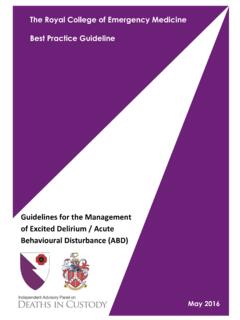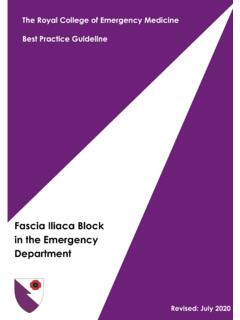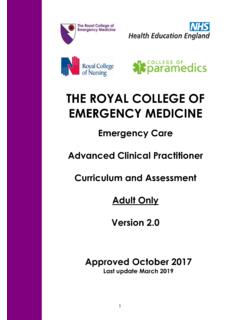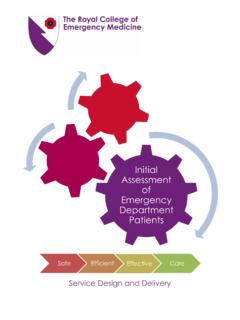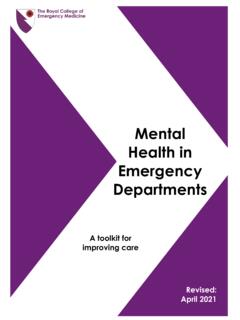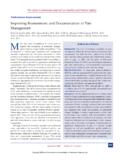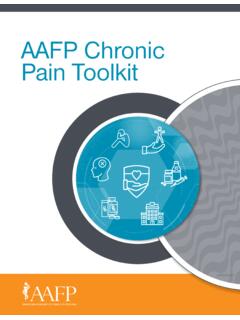Transcription of The Royal College of Emergency Medicine Best Practice ...
1 1 The Royal College of Emergency Medicine Best Practice Guideline management of pain in Adults June 2021 2 Summary of recommendations 1. Recognition and alleviation of pain should be a priority when treating the ill and injured. This process should start at triage, be monitored during their time in the ED and continue through to admission or discharge ensuring adequate analgesia is provided at all times, including beyond discharge where appropriate. 2. All Emergency departments should ensure patients with moderate and severe pain receive adequate analgesia within 15 minutes of arrival.
2 3. All Emergency departments should ensure patients in severe pain have the effectiveness of their analgesia re-evaluated within 15 minutes of receiving the first dose of analgesia. 4. All Emergency departments should ensure the routine recording of pain in a similar manner as the regular documentation of vital signs. 5. All Emergency departments should audit pain management at least annually. Audit should consider equity of analgesia provision across protected characteristics. 6. Emergency department patient surveys should include specific questions regarding pain management .
3 7. Training in pain relief for all staff involved in patient care is essential to ensure timely and effective management . 3 Scope This guideline has been developed and reviewed in order to provide clear guidance on the standards for timeliness of provision of analgesia, and to provide an approach to the delivery of analgesia for adult patients presenting to the Emergency department (ED). The guidance does not cover children, palliative care or the issue of discharge medication (covered in separate RCEM guidance). Reason for development pain management is one of the most important components in patient care, which is why it is given such a high priority in the RCEM Clinical Standards for Emergency Departments and initial assessment processes which may involve early warning systems and triage tools, such as the Manchester Triage Scale [1].
4 Introduction pain is a common presenting complaint in Emergency Departments and frequently under-recognised, under-treated and under-prioritised [2,3]. pain cannot be treated if it has not been recognised or assessed. Recognition and alleviation of pain should be a priority when treating the ill and injured. This process should start at triage, be monitored during their time in the ED and continue through to admission or discharge ensuring adequate analgesia is provided at all times, including beyond discharge where appropriate. This is dependent on many factors in the clinical patient pathway associated with processes, culture and individual prejudices.
5 There is some evidence that pain relief is related to patient satisfaction [4]. pain Assessment As part of the initial assessment, pain evaluation is an essential component. Multiple assessment tools are in use. The better known scales have not been validated in the context of an ED environment but are nevertheless satisfactory for the purpose of pain assessment and management . The recording of pain scores is often suboptimal [3]. The experience of the member of staff who first sees a patient will help in estimating the severity of the pain . Staff frequently rely on their experience or intuition when managing pain , particularly when judging the appropriate level of analgesia to prescribe and value this more highly than strict adherence to pain scores [5].
6 Simply relying on pain scores alone may be unreliable, but the scoring systems are useful in serial assessments and auditing the treatment of pain . The literature suggests that the assessment of pain in the ED is often not as good as it could be [6,7] which is particularly concerning since pain is often the reason for attending. Other clear reasons to ensure adequate analgesia include improved patient assessment, the ability to perform painful or uncomfortable procedures as 4 well as physiological benefits to providing adequate analgesia [7]. Table 1 (below) shows themes from a number of UK Emergency departments that are potential barriers to adequate pain management in the ED, adapted from Sampson et al [8].
7 Table1. Summary of barriers to effective pain management in the ED [8] Overarching Theme Narrative pain management is not perceived to be one of the organisational priorities for which ED staff are held accountable 4hr waiting time target and ambulance handover target perceived as more important Little individual feedback about pain management , the concept of excellent pain management infrequently discussed within the ED Poor pain management performance not challenged leading staff to believe pain management was being done well Failure to challenge individual staff s belief regarding the utility of pain score pain management is not prioritised within ED training and education Staff having limiting knowledge of either local or national guidance Staff relying on personal experience rather than evidence based knowledge with regards pain management Inconsistent knowledge of key pain management principles eg.
8 The peak effect of morphine, pain ladder. Low organisational priority underpinned personal beliefs about the priority of pain management Not perceived as a priority you can t die of pain Perceived low levels of control in improving pain management eg. staff shortages, two witnesses for controlled drugs pain is only one priority competing amongst many other for staff s attention ED processes and structures enable other ED priorities, but can hinder pain management Multiple handovers Focus on pain management lost amongst other issues eg. focus on flow and diagnosis Departmental layout contributing to barriers eg.
9 Location of analgesics within the ED, poor visibility, difficulty communicating between areas within the ED ED processes, including poor documentation , competencies 5 There have been numerous international studies suggesting that patient ethnicity plays a role in determining how quickly and what type of pain relief a patient receives in the Emergency department. Statistics released by the Care Quality Commission surprisingly suggest this may not be the case in the UK [9], however staff need to be mindful of the effect that a patient s ethnicity or different culture background might have on their own decisions in relation to the provision of rapid and appropriate analgesia.
10 National guidance already exists for the prompt provision of analgesia experienced during painful sickle crises [10]. Positive and negative personal biases may also manifest themselves when caring for other patient groups eg. obese patients [11], children [12]. Assessment of Acute pain in the Emergency Department A numeric rating score for pain is recommended for those patients presenting to Emergency Departments. Special consideration, however, must take place for those patients with cognitive impairment, who may not be able to express the degree of pain clearly (Appendix 2,3) No pain pain score.
